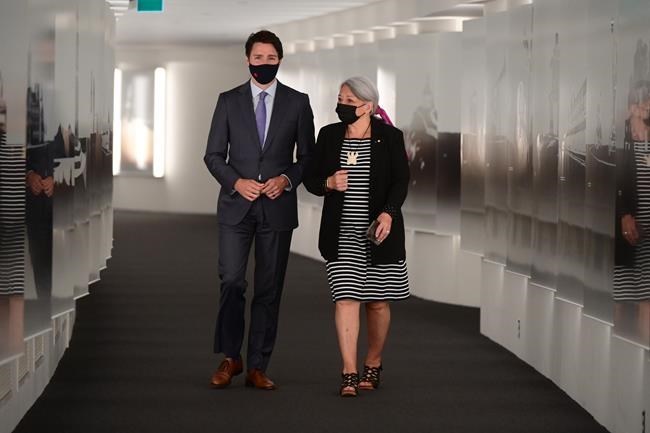OTTAWA — The naming of Canada's first Indigenous governor general could give the federal government a timely opportunity to tackle a key recommendation of the Truth and Reconciliation Commission involving the Crown, according to an expert.
One of the TRC's 94 calls to action urged the federal government to "jointly develop with Aboriginal Peoples a Royal Proclamation of Reconciliation to be issued by the Crown."
It is the only recommendation from the TRC's list that would specifically involve the participation of the Crown, as represented by the governor general.
Michael Jackson, president of the Institute for the Study of the Crown in Canada, says he believes such a proclamation would be a positive step in building a new relationship and working toward reconciliation.
The announcement Tuesday that Mary Simon, an Inuk leader and former diplomat, will be Canada's next governor general provides a unique opportunity to gather together Indigenous leaders make the Crown a place for greater open dialogue and bridge-building, Jackson said.
But Prime Minister Justin Trudeau would not commit to the royal proclamation when asked in Calgary during a news conference Wednesday, saying only that his government is moving forward on all 94 calls to action.
That work must include all institutions, he said.
"The designation of Mary Simon and her upcoming installation as governor general will mark a new step on that path to reconciliation, but the work remains," Trudeau said.
"And we will continue to work with all partners, including the governor general, where necessary, as we move towards better reconciliation with Indigenous Peoples towards a partnership we know we need to have in this country."
The Royal Proclamation of 1763, issued by King George III, laid the foundation for a constitutional recognition and protection of Aboriginal title, rights and freedoms in Canada and served as a basis for the treaty-making process throughout Canada.
This proclamation, which is sometimes called the "Indigenous Magna Carta," stated “the several nations or tribes of Indians … should not be molested or disturbed in the possession of such parts of our dominions and territories as, not having been ceded to or purchased by us, are reserved to them.”
The TRC's call to action number 45 says a new Royal Proclamation of Reconciliation, building on the 1763 decree, should reject the doctrines of discovery and "terra nullius." European officials used these doctrines to displace and control the lives of Indigenous Peoples already living in the place now known as Canada, based on the notion they had racial and religious superiority.
It also says the proclamation should adopt and implement the United Nations Declaration on the Rights of Indigenous Peoples and should aim to renew or establish new treaty relationships with First Nations based on principles of mutual recognition, mutual respect and shared responsibility for maintaining those relationships.
The TRC also saw this proclamation as an opportunity to reconcile the legal recognitions that exist between Indigenous Peoples and the Crown to ensure “Aboriginal Peoples are full partners in Confederation, including the recognition and integration of Indigenous laws and legal traditions in negotiation and implementation processes involving treaties, land claims and other constructive agreements,” the TRC document says.
A new proclamation might be mainly symbolic, but Jackson says it would demonstrate the Crown is an institution that has always been strongly supportive of Indigenous rights.
"Those principles and ideals carry on, even though mistakes have been made along the way. And they remain valid, which is why I hope the Indigenous people will continue to see the Crown as a support and a meeting place for them and the principles of their status in our country," Jackson said.
In fact, three years ago, the Institute for the Study of the Crown in Canada's founding president John Fraser and then-vice-president Nathan Tidridge, submitted a series of recommendations to several federal ministries, including Crown-Indigenous Relations and Canadian Heritage, and to former governor general Julie Payette, with ideas about how her office could better reflect the traditional relationships that are tied to the Crown in Canada.
"They submitted a brief to Rideau Hall outlining what the office of the governor general could do for reconciliation with Indigenous Peoples as a meeting place, as an influence on reconciliation. And they didn't even reply," Jackson said.
In the absence of leadership from Ottawa or the governor general, he says several lieutenant-governors and territorial commissioners, who are the Queen's representatives in the provinces and territories, have been embarking on some of this work, Jackson said.
He credited Ontario Lt.-Gov. Elizabeth Dowdeswell and Saskatchewan Lt.-Gov. Russ Mirasty especially with advancing these aims, saying they have been "quietly playing that role already: gathering Indigenous leaders together, making the Crown a place for frank talk behind-the-scenes, moving toward reconciliation."
"I think that Mary Simon is going to be very good at that. If you look at her track record and credentials … she's just the right person."
This report by The Canadian Press was first published July 7, 2021.
Teresa Wright, The Canadian Press



